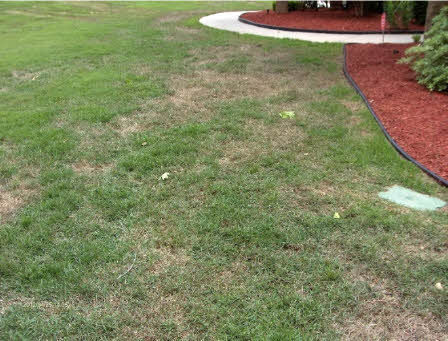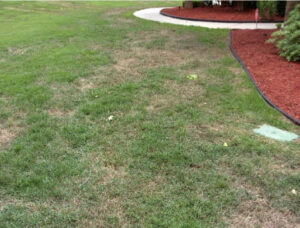To those new subscribers of the Jungle Taming Newsletter, please review the August edition containing STEWARDS OF THE SOD by Ron Cowart. That reading will bring you up to the present time of my landscape profession. That being said, ask yourself, “What is it in it for me” or to put it another way, “What is it in it for me to have a beautiful lawn”.
Taking care of the lawn is a “man-thing”. Maintaining the lawn is a status thing, and it should be. However, I know some women folk that love to mount their riding mowers and enjoy the task. I guess it gives one a sense of accomplishment.
I started Cowart Landscape Consulting in 2011, after retiring from the nursery industry, and have visited landscapes in Richland and Lexington counties. Most of the yard visits have centered on homeowner’s turf grasses.
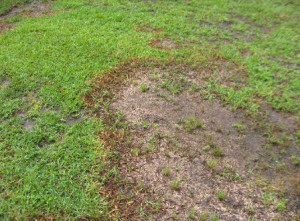 A common disease that I see is large patch. This disease is caused by a fungus that is active in the spring and fall. If it is not treated, large areas in the turf will die. I have seen homeowners re-sod these areas without proper treatment and lose their sod for the second time.
A common disease that I see is large patch. This disease is caused by a fungus that is active in the spring and fall. If it is not treated, large areas in the turf will die. I have seen homeowners re-sod these areas without proper treatment and lose their sod for the second time.
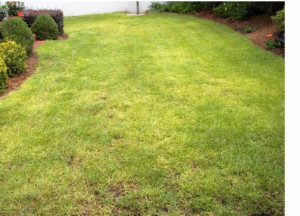 The roots growing in the soil of this centipede has ring nematodes. Last year, this centipede turf was re-sodded in the lower part of this photo. It is thinning out and will die. Notice the light green turf color.
The roots growing in the soil of this centipede has ring nematodes. Last year, this centipede turf was re-sodded in the lower part of this photo. It is thinning out and will die. Notice the light green turf color.
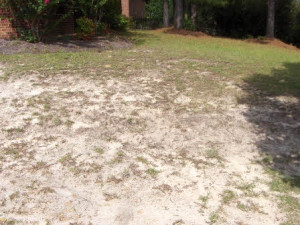 This yard was analyzed with sting and ring nematodes. Notice, the infested area is progressing into the back yard like a cancer.
This yard was analyzed with sting and ring nematodes. Notice, the infested area is progressing into the back yard like a cancer.
This zoysia is suffering from dollar spot fungus and a high soil pH.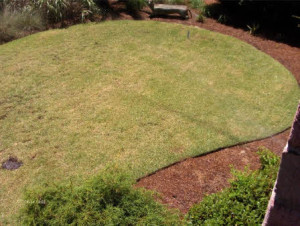
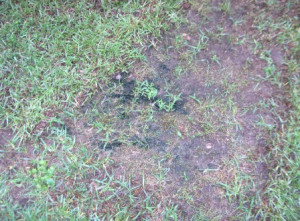 This centipede turf is suffering from blue green algae, “black scum”. It is usually found in wet lawns and lawns with a perched water tables.
This centipede turf is suffering from blue green algae, “black scum”. It is usually found in wet lawns and lawns with a perched water tables.
This empire zoysia turf had one of the worse spittle bug infestations that I’ve seen. It was caused by improper cultural practices, mowing 5 to 6 inches high and over fertilizing.
The preceding pictures show a few problems I have observed in our area. Many homeowners have wasted money and time replacing declining and dead areas in their yards with new sod. Now I ask you the reader, “What is it in it for you”? Continue reading.
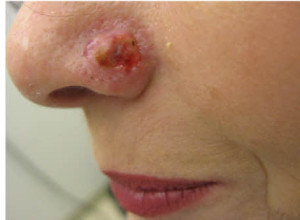 Would your doctor graft skin on this cancer from your back? No, he would identify the cancer and treat it with the proper procedure (surgery) and then lay a skin graft.
Would your doctor graft skin on this cancer from your back? No, he would identify the cancer and treat it with the proper procedure (surgery) and then lay a skin graft.
Turf is the skin of your yard.
Turf grasses do not die of themselves. There are causes, some of them are described above. There are 4 steps in re-sodding. They are (1) Identify the cause of turf decline, (2) Treat the cause of turf decline and (3) Replace the sick turf with healthy sod, and(4) monitor the health of the new turf for 1 or more growing seasons.
I have been identifying the causes and treatment of turf decline for several years. I felt that I needed to be of further service to the homeowners, therefore after passing the South Carolina Commercial Pesticide Applicators examination, I am now a certified licensed commercial applicator. Not only will I be able to identify the cause of turf decline and recommend treatment, but will be able to administer the proper pesticides to treat the causes of turf decline.
7 Steps to be taken for Lawn Improvement.
(1) Call Cowart Landscape Consulting 803-513-4242 or email Cowart Landscape Consulting cowartconsulting@gmail.com for a yard visit and more information on costs of services.
(2) Present a 1 year history covering cultural practices and materials applied to the turf.
(3) Agree for samples to be taken for soil nutrient analysis, nematode analysis and plant pathogen diagnosis. Onsite observations will be recorded.
(4) All samples will be sent to Clemson University for testing and evaluation.
(5) A personalized report will be written on the findings of the study with recommendations for treatment.
(6) A list of reliable sod installers, if needed, can be given to the homeowner.
(7) Cowart Landscape Consulting can apply recommended corrective materials, including fertilizers and pesticides, excluding sod installation.
Saving money is “What is it in it for you”. Sod preparation and installation is an expensive undertaking. Do it once and be over with it. Get the feeling of being in control.


